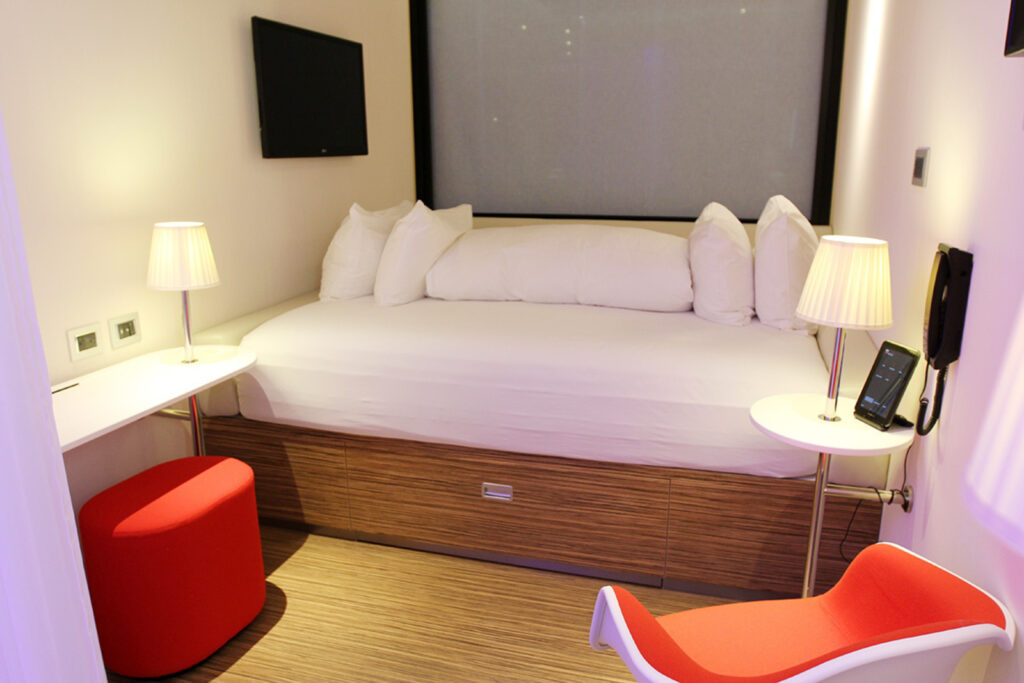THE TOP 3 TAKE-AWAYS FROM NYU’S 2016 INTERNATIONAL HOSPITALITY INDUSTRY INVESTMENT CONFERENCE
June 29, 2016

Image: The sub-200 square foot Citizen M room. Photo credit to coolhunting.com.
Earlier in June I had the pleasure of representing AXIS Architecture + Design at the 2016 NYU International Hospitality Industry Investment Conference. In my previous On The AXIS Blog post titled Three Themes to Expect at NYU IHIIC 2016, I point out how this event regularly acts as a bellwether for the hospitality industry for the coming year. To bookend that post, the 2016 event did indeed yield a number of notable take-aways, and if the NYU IHIIC holds true to its history, here’s what we can expect in the coming quarters.
Anticipate more dual-branded hotel projects coming down the pipeline
Having mercilessly risen in recent years, the increasingly high cost of real estate in many metropolitan centers and downtown cores has resulted in a number of predictable consequences. In markets where inventories of raw land and underdeveloped curbside are low or non-existent, a simple matter of supply and demand means prices for parcels of land to develop hotels on (or any real estate for that matter) have increased, sometimes with absurd momentum as has been the case in San Francisco and New York since 2009. Adapting to those higher input costs, hotel developers in heated real estate markets have been doing the obvious thing to keep their per-foot and per-key development costs down: increasing room density. Further driving increased density are local municipal councils, who themselves are responding to the shrinking stock of available land by mandating higher density for new developments. The trouble with increasing density is developers and operators are moving in opposite directions; hospitality market pressures and the contracting day-to-day economics of operating a hotel are driving the development of select-service hotels, and conversely, making full-service hotels less attractive. Unfortunately, those unattractive full-service hotels are precisely the types of operations that traditionally fill high-density footprints. In fact, the closing or repurposing of full-service hotels for operations of a different profile are becoming more commonplace, as was the case with the recent announcement New York’s historic Waldorf Astoria Hotel will close in part because of those influences.
Of course, developers are still going to want to take advantage of the shift from full-service to select-service hotels in those metropolitan markets. The strategic workaround? Where once a single full-service hotel would fit, two (and sometimes more) select-service hotels can operate. In the coming quarters, expect many new hotel developments to launch with two brands in the same footprint. And possibly with similar frequency, anticipate renovations and the repurposing of full-service hotels into multiple select-service hotels. For hotel architects like AXIS, the challenges of select-service hotels sharing a footprint are exciting: imagine how two separate lobbies, perhaps with two separate rewards-based food service areas, might handle the flow of guests.
Expect smaller guest rooms to become the status quo
In point #1 above I make the case that increasing real estate prices and economic pressures are driving increased density and pushing lower per-foot and per-key development costs. Apart from splitting single hotels into multiple hotels, how else can a developer or a hotel architect create density? By building more rooms into the same hotel of course. Luckily, for both the hotel developer and the consumer, this is a good thing. With a touch of lucky coincidence, the hotel developer’s need for increased density because of external economic factors is marrying nicely with the hospitality market’s demand for more economical and leaner hotel options. The net result is select-service hotels, which typically offer smaller rooms for lower rates compared to full-service hotels, will increasingly dominate hotel development activities, so much so that STR recently reported that up to 70% of all hotels in the pipeline are select-service.
Unquestionably, select-service rooms are smaller by nature, but how small can small be? Marriott’s select-service Moxy brand offers rooms in the 200 square foot range. Even smaller, Citizen M, a brand originally from Europe making significant headway in North America, offers rooms even smaller than that (see the image above). It’s unlikely the entirety of the select-service inventory will shrink so small, but with offerings like those gaining popularity the average room size is sure to shrink.
Focusing on marketing to Millennials will continue
Nearly two years ago I sat as an expert panelist at The Lodging Conference. One of the topics of discussion for the panel I was speaking on covered the issue of designing hotels for, and marketing to Millennials. What was a hot topic nearly two years ago is even more so now. For a whole host of reasons, including a lack of need for guestroom space due to a desire for more communal spaces, Millennials, now the largest market cohort in America, are more likely to seek the smaller and more economical offerings found at select-service hotels. As their segment continues to grow, and as their affluence continues to develop as more of them move into increasingly professional roles with their creeping age, anticipate marketing to them to gain in importance.
Cory Creath is a Principal Architect at AXIS Architecture + Design, and regular speaker at hospitality industry trade shows and events. An expert on hospitality and hotel architecture, Cory’s comments will appears regularly here in On The AXIS, AXIS Architecture + Design’s official blog and sounding board.